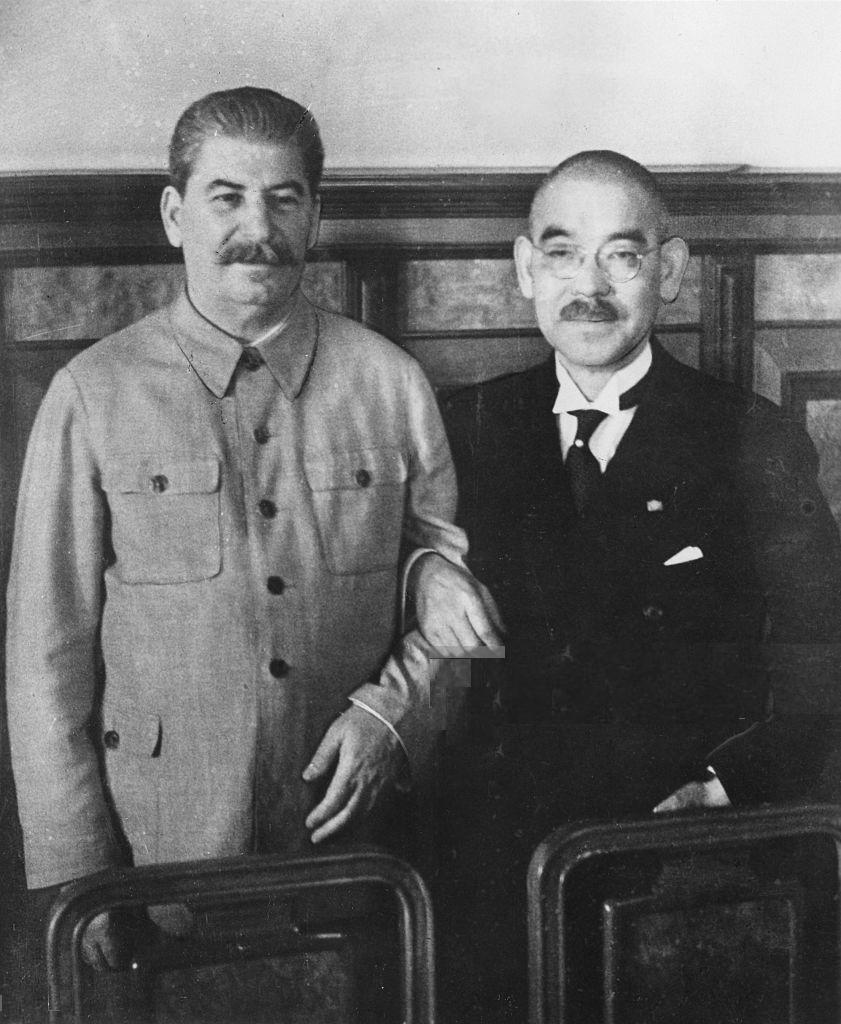
Japanese-Soviet Neutrality Pact (May 13, 1941)

Figure 1.--Here we see Stalin and Japanese Foreign Minister Yōsuke Matsuoka after the signing of the Japanese-Soviet Neutrality Pact (May 13, 1941). Matcuooka is best known for his defiant speech before the Laguae of Natiins after the Japanese invasion of Manchuria. Stalin shook hands with German Foreign Minister Ribbentrop after the signing of NAZI-Soviet Non-aggression Pact (August 1939). Here Stalin and Matsuoka are shown in a more intimate embrace. But if you look closely, it is Matsuoka who has insered his arm into this pose. Matsuoka was a major force in Japan joining the Axis. And after the failure of the Japanese Arny in clashed with the Red Army, he advocated this neutrality pact. The Germans never informed him of Barbarissa, but after the German invasion (June 22, 1941), he stronly advocated that Japan join the Germans and attack the Soviets in violation of the Neutrality Pact that he had just negotiated. Jut one of the many examples illustrating the perfiidy of Axis leaders. | |
After meetings in Berlin with Hitler and others, Foreign Minister Matsuoka went on to Moscow to finalize a neutrality treaty. At the tine, Stalin was still hoping to join the Axis and the Japanese were supporting him on this. They wanted the Soviet Union in the Axis as it would strengthen their pososition vis-à-vis the Americans. The Soviets wanted no distraction in the Far East as they expanded their territory in Europe. The Japanese wanted a quiet morthern frontier as they planned war with America and Britain. There he negotiated the Soviet–Japanese Neutrality Pact, only 2 years after the border conflict between the Soviets and Japan along the poorly defined on the Manchurian-Mongolian frontirt. border. It was signed April 13, 1941. The treaty required both narions to remain neutral if one of the two signing nations was invaded by a third nation. Both countries pledged to respect the sovereignty of Manchukuo (Japanese occupied Chinese Manchuria) and the Soviet controlled Mongolian People's Republic. The Japanese-Soviet treaty had very real significance in a world of armed camps. It meant that Japan and the Soviet Union could avoid fighting on multiple fronts. Stalin did not expect a German invasion as long as Britain and Germany were at war, but he did expect aan eventual showdown with Hitler. The Japanese were actively preparing for war with America. After the signing cermonies, Stalin, in an 'unprecedented' gesture, saw Foreign Minister Yosuke Matsuoka off at the Moscow train station. This was a sign of how important Stalin saw the Treaty. And as Barbarosa unfolded, he would be proven correct. This public display observed by the Moscow diplomatic corps sent a signal to Hitler. Stalin mean it to mstrengthen his effort to join the Axis, seeing it as strengthening his bargaining power. [Kissenger, pp. 365-66.] When the Germans launched Barbarossa only 2 months later, Stalin was convinced the Japanese were in on the deception. Japanese neutrality, however, allowed the Soviets to move Far Eastern forces west to resist the Germans. These Siberian troops, played an important role in the Soviet Winter offensive that saved Moscow (December 1941). It was also impotant to ensure pasage of Lend Lease material over the all important Pacific route. Japan's failure to stop these shipments would outrage Hitler. Slavinsky draws on recently opened Russian archival material to demonstrate that the Soviet Union was passing information about the Allies to Japan during the Second World War. One historian reports that recently opened Russian archives describes the Soviets passing information about the Allies to Japan. [Slavinsky] As the Pacific War went against Japan, the Japanese became desperate to renew the Treaty. And believed that the Soviets could help them negotiate a peace with the Americans.Stalin had no such interest. He saw major territorial gains to be made in the Far East and commited to entering the War with Japan 3 moths after the NAZIs surrendered. The Soviets after V-E Day (May 8,1945). The Soviets began a major movement of men and material east. The Japanese pressed for renewal of the Non-Aggression Treaty and ignored reports from their Mocow Ambassador that the Soviets had no interest. The Sviets informed the Japanese that thry were going to allow the Treaty to lapse 9 months before its expiration date -- April 1946. The Sovies struck in a massive offensive (August 9, 1945), the same day the second American atom bomb was dropped on Nagasaki.
Sources
Kissinger, Henry. Diplomacy.
Slavinsky, Boris. The Japanese-Soviet Neutrality Pact: A Diplomatic History 1941-1945 (New York: Routledge Curzon, 2004.), 227p.
CIH -- WW II

Navigate the Boys' Historical Clothing Web Site Baltic Pages:
[Estonia][Latvia][Lithuania]
Navigate the CIH World War II Section:
[Return to The Axis: Japan[Return to Main Axis strategic concept page]
[Return to Main World War II conferences page]
[Return to Main NAZI-Soviet Non-Aggression Pact page]
[About Us]
[Aftermath][Biographies][Campaigns][Children][Countries][Deciding factors][Diplomacy][Geo-political crisis][Economics][Home front][Intelligence]
[POWs][Resistance][Race][Refugees][Technology][Totalitarian powers]
[Bibliographies][Contributions][FAQs][Images][Links][Registration][Tools]
[Return to Main World War II page]
[Return to Main war essay page]
[Return to CIH Home page]
Created: 12:35 PM 7/12/2019
Last updated: 12:35 PM 7/12/2019



